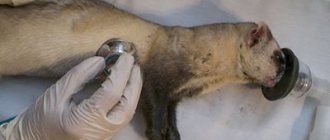Features and lifestyle
Among its relatives, the Syrian hamster is the largest, its length reaches 18 cm. Females are larger in size than males and can grow 20 cm long. Distinctive features of the animal:
- rounded ears;
- stocky body;
- small paws;
- round muzzle;
- There are four toes on the front paws and five on the hind paws.
Syrian hamsters also live in the wild and are not picky about where they live. They can be found in Asia, Africa and America. The most favorable place for an animal to live is in crop fields, where there is a lot of food. The animals live in shallow burrows. They lead an active lifestyle at night.
The only type of hamster that can be trained to a nickname. He has a well-developed intellect and friendly habits. A seemingly cute animal can be aggressive! It is common for rodents to bite. Why does he do this?
- Knows the world . If you pick up a hamster for the first time, he will definitely bite. This is how a Syrian gets to know you. Nature endowed him with hearing and smell poorly, but his tactile sense is well developed. To get to know something better, he will definitely taste it.
- Feels food . Let's say you've eaten and picked up the animal. The smell of your food is new to him, and he definitely tastes it.
- You are not lifting the hamster correctly. You need to take the animal with your hands from the side or from below. If you grab him from above he will get scared.
- Loud sounds. When you have a hamster in your hands, do not speak loudly, act calmly, he will feel it and will be kind.
- Sharpenes his teeth. If there is a lack of mineral stone or dry branches, which the animal needs to grind down its teeth, it will bite.
Habitat in nature
The Siberian hamster's natural habitat is the northern steppe of Kazakhstan and the hilly terrain of Tuva, located in Siberia.
Rodents are nocturnal: in the dark they go out in search of food - this makes it easier for them to avoid encounters with predators (owls and foxes).
As a dwelling, they use self-dug burrows, consisting of a “closet” and a nest, connected to each other by tunnels. Several passages serve to communicate with the surface.
With the onset of cold weather and shortening daylight hours, the animals begin seasonal molting, when their brown fur coat changes to white. This is necessary for camouflage - a snow-white baby is difficult to notice in the snow.
Siberian hamsters have a keen sense of smell, acute hearing and poor eyesight, which is apparently associated with life underground. They recognize each other by the smell emitted by special glands located in the abdomen.
Types and colors.
The true color of the Syrian hamster is red, more like a mahogany shade. It was this kind of inhabitant that was first discovered in Syria and brought to Europe. Its peculiarity: gray ears and black eyes. With age, the color of the animal changes, the undercoats become grayer, but the golden hue of the top remains the same. There are other colors of the animal:
- The black by deep charcoal hair color, white paws and chin. It appeared in France in the process of mutation.
- The white animal has red eyes and gray ears.
- The color “ivory” is very similar to white, but has a distinctive feature. A milk hamster can have either black or red eyes.
- The gray animal has dark gray ears, stripes on its cheeks, and a gray spot on its chest. The coat itself is light in color with dark tips. The undercoat is blue.
As a result of mixing, other shades were obtained:
- Honey
- Smoky
- Blue mink
- Yellow
- Cream
- Chocolate
- Brown
- Beige
Syrian hamster Blue mink
Syrian Hamster Brown
Syrian hamster Honey
Syrian Hamster Beige
Syrian Hamster Yellow
Syrian hamster Cream
Syrian Hamster Smoky
Hamster can be spotted. Currently, the Angora breed has been bred to have long fluffy hair.
Long-lived hamsters
Knowing how long Syrian hamsters live, it is not surprising that representatives of this breed are most often among those who please their owners for a long time. It was found that some individuals reached 7 years of age. This is very rare. But if an ornamental rodent has lived up to 4 years, it can also be safely called a long-liver.
How long do hamsters live?
The average lifespan of a hamster is 3 years. In the wild, rodents rarely live past the age of two. In order for an animal to be healthy, it needs to be provided with good conditions. Particular attention should be paid to the cage and food.
Cage requirements:
- It must be big. Although the animal is small, it requires space. The hamster loves to run, bury itself in sawdust, and look for food. Create for him the conditions of an endless field within the apartment. If you plan to have more than one animal, remember that Syrian hamsters must live separately. You can put two cells next to each other, but you shouldn’t put them together.
- Good ventilation is of no little importance. It is better to choose a cage from metal bars. Bacteria multiply quickly in an aquarium and plastic houses, which will only harm your pet’s health.
- Ease of cleaning and maintenance. Plastic cages are the most difficult to clean.
- Stock up on an extra house for your hamster. The animal can be transplanted into it when cleaning is required.
- The bottom of the cage should be uniform. A grate on the floor is not comfortable for your pet, as its nails will get caught.
- Consider a place to play, relax and eat.
- Choose the space between the rods no more than 2 cm, otherwise the animal will easily escape.
Factors affecting the lifespan of a hamster
You should be aware that when you get a hamster as a pet, separation from him will come sooner than you would like - after about 2.5-4 years. The lifespan of a hamster at home is influenced by many factors. Taking them into account, you can extend the life of your favorite animal as much as possible.
Genetics
When choosing a hamster, if possible, you need to find out about its pedigree. This information will help determine the risks of hereditary diseases.
With a high degree of probability, the animal is susceptible to illnesses if it has had such diseases in its family as:
- diabetes;
- tumors;
- dental abnormalities;
- eye problems;
- obesity.
You should pay attention to those individuals who have long-livers in their family - most likely they have strong immunity and good health.
Conditions of detention
The keeping of a decorative rodent should be organized so that it does not experience stress. A calm, quiet environment without harsh sounds or bright lights is the key to a long and happy life for a hamster. It is recommended to choose a spacious cage with such a distance between the twigs that will not allow the animal to get through them. The filler or sawdust in the hamster's home should be changed promptly to prevent an unpleasant odor and the spread of pathogenic bacteria.
Feeding
The health of a hamster directly depends on its diet. Your pet's diet should be balanced and contain vitamins and minerals. Most commercially produced food completely satisfies the rodents' need for vital nutrients. However, sometimes you can pamper the animal with raw carrots, potatoes, berries and fruits. But it is necessary to strictly ensure that the animal does not overeat. Most hamsters are prone to obesity, which can shorten their lifespan. The animal must have constant access to clean water.
Taking care of your health
A healthy hamster is active, has a good appetite, shiny, soft fur, and clear eyes.
You should immediately contact your veterinarian if you have the slightest doubt that your pet is feeling well or is experiencing alarming symptoms:
- activity has decreased, the animal sleeps a lot;
- hard breath;
- loss of appetite;
- dull coat;
- baldness;
- discharge from the eyes;
- lumps and bumps on the body.
Timely measures can save the animal's life.
Ensuring activity
In their natural environment, hamsters run long distances every day while searching for food. The activity and energy of animals inherent in nature requires its outburst at home. To maintain the health of an ornamental rodent, you should provide it with conditions for outdoor games. The cage's equipment should include a running wheel, various slides, labyrinths and tunnels. A nimble pet should not be allowed out of its house - this can be fatal to its life. A nimble animal can climb into hard-to-reach places from where it cannot be reached, get hurt, fall from a height, or be accidentally crushed.
What to feed a hamster?
The diet of an animal in a wild and domestic environment is significantly different. To keep your furry friend healthy, you should refrain from:
- Sweet
- Fat
- Salty
The hamster's body cannot digest sugar; if you overfeed it with junk food, it will not live long. In addition, I will gain a lot of weight.
The animal's main diet includes berries, small branches, and vegetables. You can find a huge range of food in stores. But all this is dry food. To be healthy, your pet needs fresh vegetables and fruits:
- Carrot
- Pumpkin
- Turnip
- Salad
- Zucchini
- Radish
- Pear
- Grape
- Persimmon
- Apple
You should not get carried away with potatoes, fruits, cabbage, as they contain sugar. It is better not to give citrus fruits, fermented milk, nuts, seeds, chocolate to the animal. The Syrian hamster loves flour: cereals, pasta, bread, as well as milk and boiled meat.
Under no circumstances should food be used for guinea pigs or other rodents! Everyone has their own diet, be careful!
Main diseases of Syrians and their prevention
Syrian hamsters very rarely get sick. To minimize the risk of disease, you need to buy them from a registered breeder and keep them properly. Regular checks with a veterinarian are sufficient prevention for them. And yet, Syrians can sometimes get sick.
Let us highlight the main signs of deteriorating health in a hamster. If you notice them, take your pet to the veterinarian for an examination. Home treatment is not the best option.
So, the signs you should pay attention to:
- lack of appetite, strong pickiness in choosing foods;
- increased secretion of saliva, wet fur from below the muzzle;
- digestive disorders: liquid, dry or hard feces;
- tearfulness or purulent discharge covering the eyelids;
- respiratory tract diseases: wheezing, wheezing;
- deterioration of the coat: hair loss, wounds, scratching;
- reluctance to be physically active
- trembling, convulsions, loss of coordination;
- unnatural formations on the hamster's body.
How to determine gender?
The female and the male have their own distinctive characteristics not only in character, but also in appearance. Knowing the gender is important if you are going to keep several animals together. Two females in one house will never get along, but with males things are simpler. To avoid unexpected offspring, it’s worth finding out who you put in the same cage. It is better to determine the sex of an animal older than a month. Here are the main ways:
- In February it is easier to identify a male, since his testes are swollen and his testicles are more visible.
- The female has a rounded back, while the male has a sharp back. This difference is noticeable when viewed from above.
- The male has two nipples on the abdomen, and the female has four.
- If upon examination it appears that there is only one outlet, then it is definitely a girl. For boys, the distance between them is greater.
- The female's belly has denser fur.
Optimal age of a hamster when purchasing
Adolescence is the optimal age when it is better to buy a hamster.
There are several reasons for this:
- adults live for a short period of time;
- Rodents that are too small may not tolerate separation from their mother and a change of environment.
It is recommended to purchase a male at the age of 4 weeks. When choosing a female, you need to take into account that at 2 months they begin puberty. If all the hamsters lived in the same house, then the girl may be pregnant.
How to care?
Basic requirements for caring for a Syrian hamster:
- You need to clean the cage twice a week.
- Change the water once a day.
- The animal's cage must be equipped with a wheel, a feeder, a drinking bowl and a house where it will sleep. Fortunately, most manufacturers have already provided these conveniences.
- Sawdust 3 cm thick is placed at the bottom of the cage, where the animal cleans itself. It is not recommended to lay sawdust on long-haired hamsters; their fur may become matted. For these, it is better to use paper napkins or natural wood filler.
- For physical activity, it is necessary to install a “sports complex”, which consists of various obstacles, perches, and a large wheel. Hamsters gain weight very quickly; activity will not hurt them.
- A drinking bowl is required with a volume of 50 ml.
- Use a feeder about 7 cm wide.
- You need to feed your Syrian hamster 2 times a day: morning and evening.
- You cannot wash the animal. If you are worried about its cleanliness, then install a sand bath.
- It is better to comb long-haired individuals with a toothbrush.
- The animal can be let out for a walk around the house, but only if it is accustomed to being handled.
Watch your pet, keep the cage clean and tidy. It is important not to forget to change the water; water is an important source of nutrition for hamsters.
How to extend the life of a hamster: basic rules
To extend the life of a Syrian hamster, you must follow basic maintenance rules:
- Position the cage in such a way as to avoid drafts and areas with constant temperature changes. But do not place the cage close to heating devices. Changes in temperature can cause illness in the baby. The ideal temperature for a rodent is 18-20 degrees;
- Try not to move your pet's house around the apartment . Avoid frequent long journeys. A change in even the slightest environment causes stress in the Syrian hamster;
- Despite the fact that hamsters get along with other animals, it is better to get Syrians when there are no cats or dogs in the house. Noisy neighbors will certainly cause danger and fear in the baby;
- Make sure your hamsters always have food and access to water. Regularly scald dishes to get rid of bacteria;
- Do not leave the cage near luminous objects or in the open sun , as Syrian hamsters do not tolerate bright light.
Buy 4 week old males
How to tame?
It takes time for a hamster to get used to its new owner. Here are the basic rules for taming:
- Do not touch the hamster for several days, as soon as he gets used to the house, he will become more friendly.
- Place the cage in a crowded place, so the taming process will go faster.
- Hamsters often sleep during the day, so you don't need to wake him up, he will become irritable. Postpone your acquaintance to the evening.
- Talk to the animal, so it will quickly get used to your voice. Call him by name. Perhaps he will remember it faster.
- Offer your hamster a piece of biscuit through the cage and wait for him to show interest.
- Start hand feeding unobtrusively. Just place a treat in your palm and wait.
- Now you can try to pick up the animal, but do it from the side or from below. By taking the animal from above, you will scare it. The palm should form a cup, this is comfortable for both.
- For the first time, it is better to lift the hamster off the sofa or bed, so there is less chance of harming him if he falls. After all, the animal is very nimble and agile.
- While holding the animal, provide it with shelter by covering the top with your palm.
- You cannot pet the animal on the head, only on the back.
The main thing is to remain patient and not to grab an animal that runs away. This way the hamster will be scared of you forever and it will be very difficult to earn his trust. The taming process does not take much time - from two weeks to a month.
Important! Handle your pet only with clean hands! If he senses a foreign odor, he may bite.
Reproduction.
It is better to mate a female at the age of four months, and a male at three months. The fetus is gestated for only eighteen days. Before birth, the cage must be thoroughly disinfected and cleaned. Either four or fifteen cubs can be born. They feed on mother's milk. After 28 days, they begin to get accustomed to adult food. Touching the offspring is prohibited. If the female smells a foreign odor, she will simply eat the young. A young mother needs to be fed more cottage cheese, yolk, and boiled chicken. You should not disturb the animal until the children grow up.
Diseases.
A sick hamster can be easily identified by its habits. He starts hiding and sleeps a lot. The coat becomes unkempt and disheveled. The animal is lethargic, does not play, does not eat or drink, loses weight, its eyes are closed. The main reasons for poor condition:
- Unfavourable conditions
- Poor nutrition
- Stress
Hamster diseases can be divided into those that are contagious to humans and those that are not. The first group includes:
- Infections
- Parasites
- Fungi
The source of infection can be a person, an animal, food, or bedding.
The most common diseases are:
- Lymphocytic choriomeningitis is transmitted from other animals. An adult hamster suffers from it asymptomatically, while young animals suffer from conjunctivitis and damage to the respiratory system. Therefore, it is often recommended not to purchase a hamster under three months old.
- Intestinal diseases accompanied by diarrhea. In this case, the animal dies from dehydration. To save him, a course of antibiotics and more fluids are needed. Prevention measures: regular cage cleaning.
- The herpes and influenza virus is characterized by a runny nose and inflammation of the eyes. The animal can recover on its own in 3 days, with good care.
- Pneumonia is severe, with fever and wheezing. The animal is pale and inactive. As a rule, the disease leads to death.
- Demodicosis is accompanied by damage to the subcutaneous tissue by mites. If the hamster is peeling and itching, then this is not an allergy. Fortunately, the disease is treatable. An experienced veterinarian can easily save your pet.
- Intestinal parasites. It is difficult to judge an infection from an animal’s behavior. If your hamster eats a lot and is losing weight, then you should give him the drug “Shustrik” to drink. It will even be useful for preventive purposes.
- Conjunctivitis is not a contagious disease. If your animal's eyes stick together and run, wash them with furatsilin solution and drop in sodium sulfacyl (Albucid) or chloramphenicol.
If a pet is bitten, then a rabies injection is not given, but the wound must be properly treated. It is worth noting that diarrhea can occur not only due to infection. Unbalanced nutrition, too juicy food also leads to digestive disorders.
Cases of injury while walking around the house cannot be ruled out. If the heat and light regime is not observed, heat stroke or hypothermia may occur. Always keep a disinfectant in your first aid kit, especially if you have two pets in a cage.
How much does a Syrian hamster cost?
The Syrian hamster is inexpensive - about 300 rubles. These animals reproduce quickly, so they can often be received as gifts. The biggest costs you will incur are providing living conditions for the animal. This is where its total cost begins to add up:
- An inexpensive medium-sized cage will cost a thousand rubles, larger ones are already more expensive.
- Drinking bowl 200 rubles
- Feeder 150 rubles
- Wheel from 200 to 500 rubles
- You can make obstacles, tunnels, and ladders with your own hands.
- A running ball is a great thing for walking around the house, it costs 200 rubles.
- Russian-made hamster food will cost from 80 rubles per kilogram. There are more expensive analogues starting from 300 rubles. In addition to food, the animal needs to chew on mineral stone, fresh fruits and vegetables, and dry sticks.
The total cost consists of all the listed components.
Buying Syrian hamsters
Such an animal is sold in pet stores, through advertisements or on the market. At the same time, many who want to purchase a Central Asian hamster on the market should be warned, since there is no guarantee of purchasing a healthy animal.
Short-haired types of Syrian hamsters can cost around 300 rubles maximum, while long-haired types are more expensive and will have to pay up to 600 rubles for them.
Buying a Hamster New Pet Syrian Hamster First Day | Elli Di Pets
Interesting facts and myths about the Syrian hamster.
Like any animal, the Syrian hamster has its own interesting features:
- trained to hands, he can sleep with his owner;
- females often eat their young;
- hamsters store food in their cheeks;
- these rodents are found in mountains more than three kilometers high;
- the hamster swims well, using its cheeks as a life preserver;
- the animal can store more than 80 kg of food;
- the animal has poorly developed vision, it does not distinguish colors;
- a hamster in its wheel covers a distance of more than 10 kilometers;
- he loves to drag shiny things found in the forest into the hole, leaving a branch or stone in their place, thereby making an exchange;
- in Vietnam it is forbidden to have hamsters, as they are carriers of many diseases;
- food is placed behind the animal’s cheek exactly as much as it weighs;
- The hamster's teeth grow constantly, so he needs to grind them down;
- the largest hamster weighs 500 grams;
- females can temporarily stop pregnancy if they are nursing;
- hamsters do not know how to recognize heights, so they often fall and get injured;
- cubs are born with teeth;
- The Syrian hamster is listed in the Red Book as it is on the verge of extinction.
What to do if your pet dies
The death of a beloved pet is always a sad but inevitable event. When the time has come to say goodbye to the animal forever, you need to decide how to bury it. You can use cremation services, which are provided by most veterinary clinics. You can also find out where the pet cemetery is and make a grave for your pet there. Another option for burying a hamster is in the forest. It is important to know that, according to sanitary and epidemiological standards, it is prohibited to bury animals in city parks, flower beds, and courtyards.
It doesn’t matter what breed the pet is – some people like Djungarian hamsters, while others like Syrian or Siberian hamsters. The main thing is to give your little friend love, care, attention, and then the animal’s life will be as long and bright as possible.











